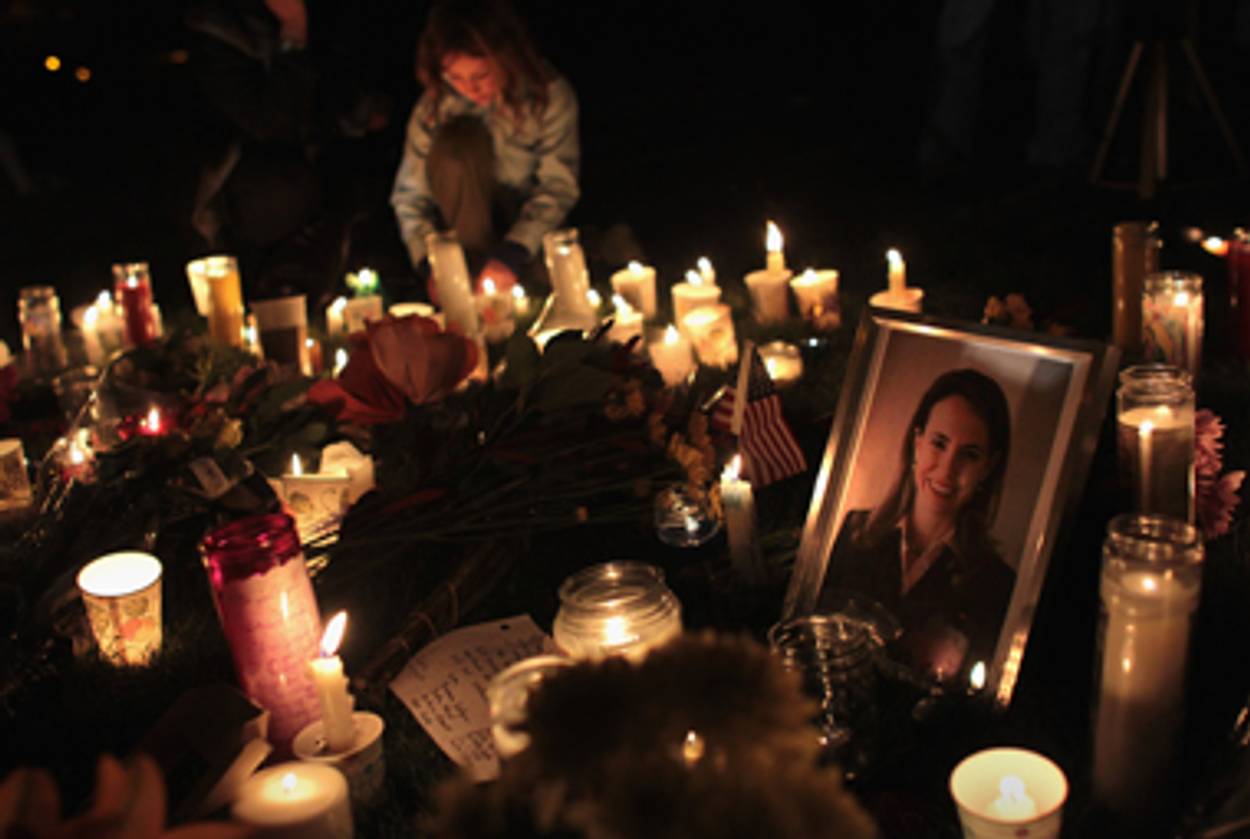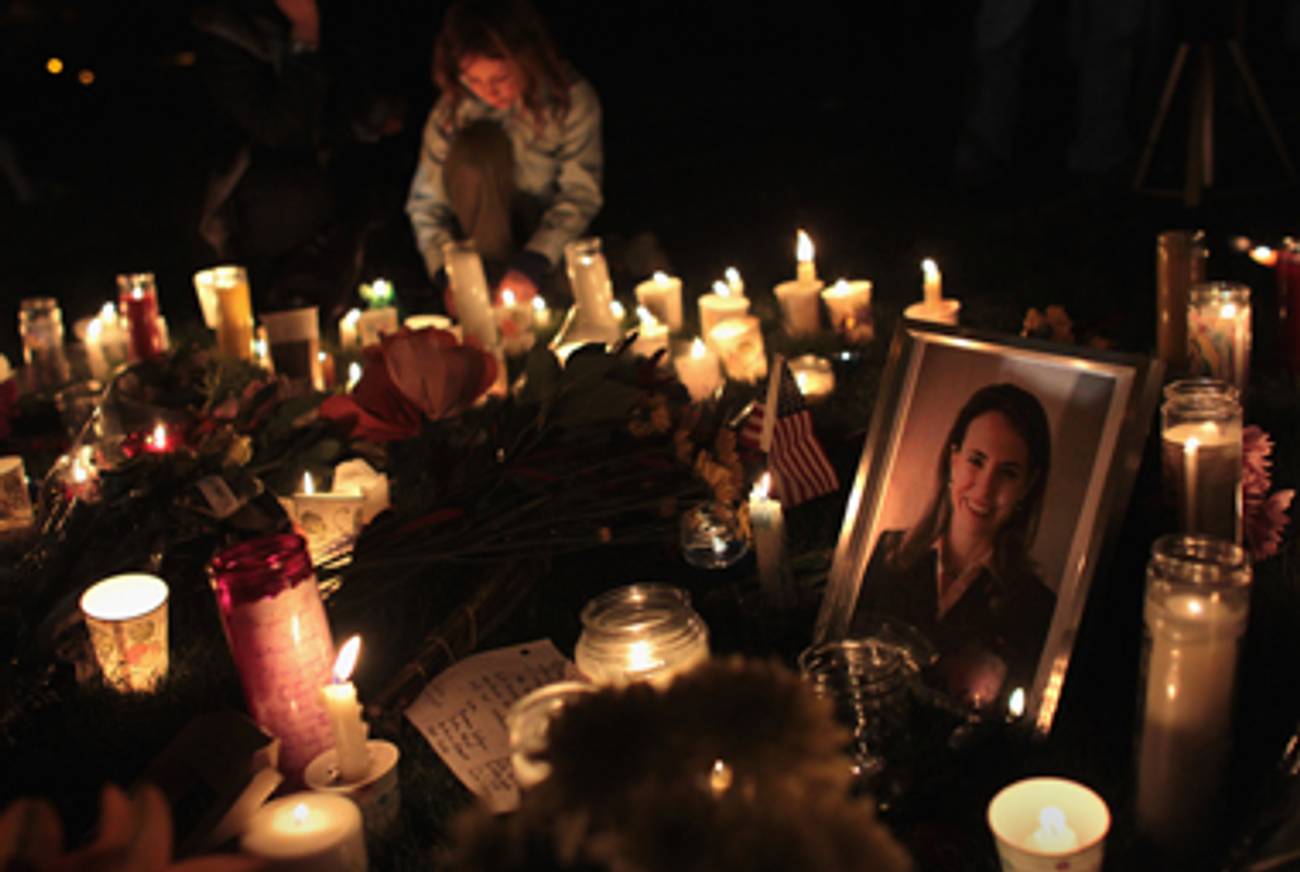Vigilant
From University Medical Center, where Rep. Gabrielle Giffords is being treated, to her synagogue, where the rabbi led an emotional service, Tucson residents gathered to pray for the victims of Saturday’s shooting attack




The Safeway supermarket where six people were killed and 13 wounded in the attempted assassination of Rep. Gabrielle Giffords was still cordoned off when I arrived in Tucson on Saturday afternoon. Although Jared Lee Loughner’s alleged plan to assassinate the Democratic and Jewish Congresswoman had apparently failed, he had succeeded in turning the La Toscana Village shopping mall into an appalling yellow-taped crime scene. Five people were still arriving to retrieve their loved ones, and no cars were being allowed to exit the parking lot, so I parked across the street and walked over. There wasn’t much to see, apart from the empty scenes that were being shown on television. Driving away I passed a giant billboard advertising the Pima County gun fair.
At a press conference later that evening, held at the Westwood Look Resort, close to La Toscana, Sheriff Clarence W. Dupnik added his two cents to the swirling debate over what appeared to be a political crime committed by a lone psychotic. “We have become the Mecca for intolerance and bigotry,” Dupnik said of Arizona. “Unbalanced people are particularly susceptible to vitriol.” The shooting, he said, took seven minutes. “There’s never security at her events,” he said. “She’s never asked for nor refused security.” I listened from the door with a few other reporters who also hadn’t thought to bring credentials. We were joined briefly were a handful of elderly hotel guests, who complained that the resort’s staff had promised them that they could attend, too. The guests eventually decided they would hear the proceedings better from the bar.
By the time I got to University Medical Center where Rep. Giffords was lying in critical condition, at about 9 p.m., there was a gaggle of perhaps three dozen well-wishers being circled by journalists.
Perhaps 20 feet away, a Latino family was praying loudly, having positioned themselves at a respectful distance from the quiet mourners. Some of the people in the circle were shaking hands, hugging, and thanking each other for coming. Others were tending to an impromptu memorial, making sure the candles didn’t set fire to the letters, flowers, signs of support, and other offerings. Most of the notes were addressed to Giffords. There was also a picture of Judge John M. Roll, who had been killed. I spoke with two 21-year-olds, both born and raised in Tucson: Elana Satten-Lopez, a student at Haverford College, and Thomas Myers, who attends the University of Arizona.
“We need to show this is not representative of Tucson,” Satten-Lopez said plaintively. “It’s just one person.”
“The political climate is so crazy,” said Myers.
“We watched some of his YouTube videos, but we didn’t understand them,” Satten-Lopez said. “They didn’t make any sense.”
An older couple, Charles Alexander and Cynthia Miller, stood nearby. “She’s such a good person,” Miller said. “She’s helped some friends of mine when nobody else could.”
***
Congregation Chaverim, the Reform synagogue Giffords attends, is a plain brick building with thick glass windows. The interior is largely unadorned. Small tapestries and red curtains hang from pastel pink walls, and a Hanukkiah sits on top of a piano. Yesterday morning more than 150 people attended a service led by Rabbi Stephanie Aaron, a small woman in a prayer shawl. When people came to speak to her she would either hug them, or hold their arm. When she cried she seemed even smaller, until the cantor put her arms around her. Then she grew into the embrace.
Rabbi Aaron, who presided over Giffords’ wedding to Navy Capt. Mark Kelly, an astronaut, often struggled with tears as she described Gabby and said blessings for “the afflicted.” Everyone in the congregation looked miserable. Some more Orthodox Jews wouldn’t consider Aaron, a woman, a legitimate rabbi, it occurred to me. She’s one hell of a rabbi.
Aaron began the service with a niggun, a prayer of lament, and then launched into two stories:
“A hasid is depressed and goes to see the rabbi. He’s explaining his problem when the fire begins to go out. The rabbi vigorously jabs the fire with a poker. ‘Do you see what happened there? When the embers spread out they begin to dim, when they come together they reignite. So too with people.’ ”
The other story was a tale about the Baal Shem Tov, the father of Hasidism. “This is a story we’ve unfortunately told too many times,” the rabbi said.
“The Baal Shem was resting after a long day doing good works,” she began. “A melech, an angel, woke him. Suddenly they were flying and came to a clearing where a boy stood. On one side of the boy was a sea of hatred and violence, on the other was an abyss of our anxieties. The Baal Shem Tov tried to call out to the boy, but his lips were sealed. However the boy’s eyes suddenly widened, and he saw what surrounded him. Frozen, he tottered on the brink. The Baal Shem Tov finally forced a single word from his lips: ‘Fly!’ ”
Sobs and laughing infants punctuated the service. One woman was so wracked with sorrow that she struggled to rise during the Mourner’s Kaddish and remained seated with a neighbor’s arm around her.
Melanie Nelson, who leads the Pima County Interfaith Council, said a prayer for people to come together. She told me later that whenever the interfaith council requested a meeting with the congresswoman or needed something, Gabe Zimmerman, a Giffords aide who was also killed in the shooting, would arrange help.
Abraham Byrd, a 6-foot-3-inch elderly doctor, was standing in the back. He is not a member of the congregation; he isn’t Jewish. With tears running down his cheeks, he explained that he attended the service “out of respect and solidarity.” “It’s her congregation that supports her and gives her to us,” he said.
Eve Shapiro, a member of the congregation, is a pediatrician who had worked with Giffords on health-care policy. “Everyone’s still in shock,” she said. “Just such a thing to happen here.” She attended the service because she needed to be with the community, she said, “and in a place of Jewish healing.”
The service was run entirely by women, which seemed appropriate. As Giffords said in her first congressional race, “If you want something done, your best bet is to ask a Jewish woman to do it. Jewish women have an ability to cut through all the reasons why something should, shouldn’t, or can’t be done and pull people together to be successful.”
After the service was over I spoke at length with the rabbi, who had been at the hospital late the previous night. “They were doing some tests with her, so I’m waiting for them to call me until I go back,” she said. I asked her how the community was handling the shock. “There’s a real sense of people reaching out for one another,” she said. “There’s a sense of people wanting to be together. We want to begin the work of preventing this from ever happening again in our society.”
I asked her to describe the Jewish teachings that would apply to such a terrible event. “I think there’s several strands of Jewish thought,” she said. “For example, the mishaberach, the healing prayers, calling on our ancestors to bless and heal us. The body should have healing, and the full self should have healing. And asking everyone who needs healing and should be healed. There should be an ever-expanding circle into the universe from this one prayer. That’s a very helpful prayer.”
She continued talking about the need for yechidah, or togetherness. “Being connected in togetherness,” she said. “Recognizing everyone in God’s image. I think that’s where we’ve gone wrong. We don’t do that anymore.”